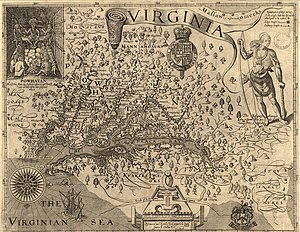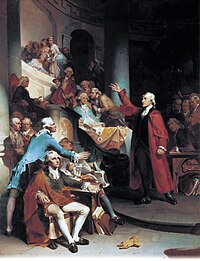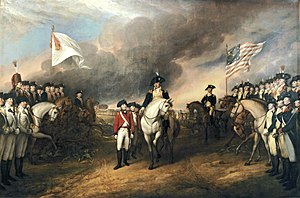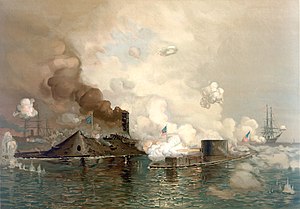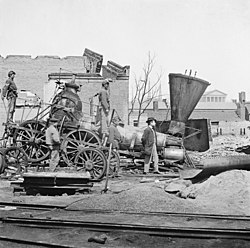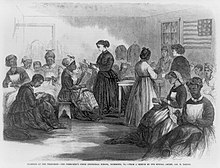History of Virginia
In the late 16th and early 17th centuries, a chief named Wahunsunacock created this powerful empire by conquering or affiliating with approximately 30 tribes whose territories covered much of what is now eastern Virginia.
[9] Recorded in the states of Maryland and Pennsylvania throughout the 17th century, they eventually made their way into the Ohio River Valley, where they are believed to have merged with a variety of other native peoples to form the powerful confederacy that controlled the area that is now West Virginia until the Shawnee Wars (1811–1813).
[47] Another Spanish party, captained by Antonio Velázquez in the caravel Santa Catalina, explored to the lower Chesapeake Bay region of Virginia in mid-1561 under the orders of Ángel de Villafañe.
The expedition consisted of two Dominican friars, thirty soldiers and Don Luis, in a failed effort to set up a Spanish colony in the Chesapeake, believing it to be an opening to the fabled Northwest Passage.
[56] On the second voyage, Raleigh learned that, while the chief of the Secotans was indeed called Wingina, the expression wingandacoa, heard by the English upon arrival, actually meant "You wear good clothes" in Carolina Algonquian, and was not the native name of the country, as previously misunderstood.
Under orders from London to seek a more inland location safe from Spanish raids, they explored the Hampton Roads area and sailed up the newly christened James River to the Fall Line at what would later become the cities of Richmond and Manchester.
After several failed leaders, Captain John Smith took charge of the settlement, and many credit him with sustaining the colony during its first years, as he had some success in trading for food and leading the discouraged colonists.
Back in England, the Virginia Company was reorganized under its Second Charter, ratified on May 23, 1609, which gave most leadership authority of the colony to the governor, the newly appointed Thomas West, 3rd Baron De La Warr.
Perhaps nowhere was this more progressive than at Sir Thomas Dale's ill-fated Henricus, a westerly-lying development located along the south bank of the James River, where natives were also to be provided an education at the Colony's first college.
With coordinated attacks, they struck almost all the English settlements along the James River, on both shores, from Newport News Point on the east at Hampton Roads all the way west upriver to Falling Creek, a few miles above Henricus and John Rolfe's plantation, Varina Farms.
Bennett was followed by two more "Cromwellian" governors, Edward Digges and Samuel Matthews, although in fact all three of these men were not technically appointees but were selected by the House of Burgesses, which was really in control of the colony during these years.
[64] About 60 percent of white Virginians were part of a broad middle class that owned substantial farms; By the second generation, death rates from malaria and other local diseases had declined so much that a stable family structure was possible.
In 1691, Sir Francis Nicholson, the governor, organized competitions for the "better sort of Virginians onely who are Batchelors," and he offered prizes "to be shot for, wrastled, played at backswords, & Run for by Horse and foott.
[77] By the 1730s, the Three Notch'd Road extended from the vicinity of the fall line of the James River at the future site of Richmond westerly to the Shenandoah Valley, crossing the Blue Ridge Mountains at Jarmans Gap.
The struggle for religious toleration was played out during the American Revolution, as the Baptists, in alliance with Thomas Jefferson and James Madison, worked successfully to disestablish the Anglican church.
The defeat of the Royal Navy by Admiral de Grasse at the Battle of the Virginia Capes ensured French dominance of the waters around Yorktown, thereby preventing Cornwallis from receiving troops or supplies and removing the possibility of evacuation.
In 1772, a Virginia House of Burgesses committee, including Thomas Jefferson and Benjamin Harrison V, had submitted a petition to King George of England, requesting that he abolish the slave trade.
After the second rebellion, the legislature passed laws restricting the rights of free people of color: they were excluded from bearing arms, serving in the militia, gaining education, and assembling in groups.
As the new nation of the United States of America experienced growing pains and began to speak of Manifest Destiny, Virginia, too, found its role in the young republic to be changing and challenging.
Virginia had been devastated by the war, with the infrastructure (such as railroads) in ruins; many plantations burned out; and large numbers of refugees without jobs, food or supplies beyond rations provided by the Union Army, especially its Freedmen's Bureau.
Other Republicans in Congress refused to seat the newly elected state delegation; the Radicals wanted better evidence that slavery and similar methods of serfdom had been abolished, and the freedmen given rights of citizens.
[135] After heated debates over disfranchising Confederates, the Virginia legislature approved a Constitution that excluded ex-Confederates from holding office, but allowed them to vote in state and federal elections.
After the Readjuster Party disappeared, Virginia Democrats rapidly passed legislation and constitutional amendments that effectively disfranchised African Americans and many poor whites, through the use of poll taxes and literacy tests.
The Progressive Era after 1900 brought numerous reforms, designed to modernize the state, increase efficiency, apply scientific methods, promote education and eliminate waste and corruption.
Swanson's coalition of reformers in the legislature, built schools and highways, raised teacher salaries and standards, promoted the state's public health programs, and increased funding for prisons.
With federal help, in they set up a county agent system (today the Virginia Cooperative Extension) that taught farmers the latest scientific methods for dealing with tobacco and other crops, and farm house wives how to maximize their efficiency in the kitchen and nursery.
By 1940, new highway bridges crossed the lower Potomac, Rappahannock, York, and James Rivers, bringing to an end the long-distance steamboat service which had long served as primary transportation throughout the Chesapeake Bay area.
The buildup for the war greatly increased the state's naval and industrial economic base, as did the growth of federal government jobs in Northern Virginia and adjacent Washington, DC.
In the western portion of the state, completion of north–south Interstate 81 brought better access and new businesses to dozens of counties over a distance of 300 miles (480 km) as well as facilitating travel by students at the many Shenandoah area colleges and universities.
The recent expansion of government programs in the areas near Washington has profoundly affected the economy of Northern Virginia whose population has experienced large growth and great ethnic/ cultural diversification, exemplified by communities, such as Tysons, Reston and dense, urban Arlington.


